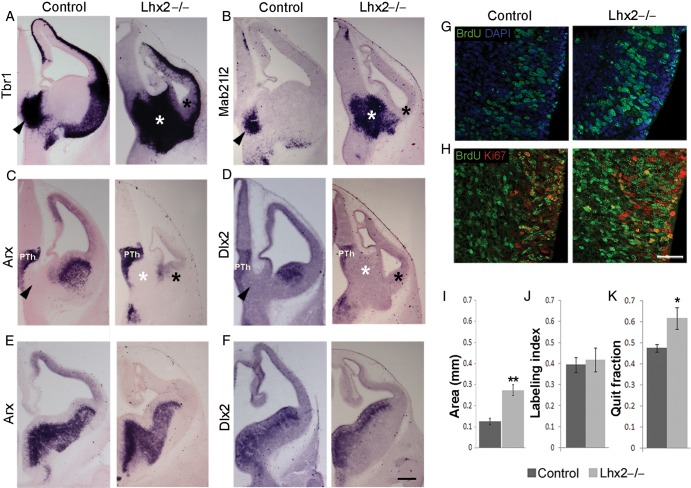Figure 5.
The thalamic eminence expands in the Lhx2 mutant. (A and B) Tbr1 and Mab21l2 expression in the mantle of the thalamic eminence in E12.5 control brains (arrowheads) reveal a profound expansion of this territory in the Lhx2 mutant (white asterisk). (A–D) The Lhx2 mutant CGE at E12.5 appears morphologically reduced and lacks Arx expression in its mantle (black asterisk, C) and Dlx2 expression in its ventricular zone and mantle (black asterisk, D). (E and F) Arx and Dlx2 expression appear normal in the LGE and MGE (E and F) and prethalamus (PTh; C and D). Arrowheads in control sections and white asterisks in Lhx2 mutant sections in A–D indicate the thalamic eminence. (G and J) Sections of E11.5 control and Lhx2 mutant brains, after a 2-h BrdU pulse, processed for BrdU and DAPI staining. Labeling indices (BrdU+ cells/total DAPI+ cells) at E11.5 are similar in the thalamic eminence of control (39%) and Lhx2 mutant (42%) brains. (H and K) Sections of E12.5 Lhx2 control and mutant brains harvested 1 day after BrdU administration at E11.5; and processed for BrdU–Ki67 double immunohistochemistry. The quit fraction (BrdU+; Ki67− cells/total BrdU+ cells) is significantly greater in the Lhx2 mutant thalamic eminence (62%; P < 0.05) when compared with control brains (48%). (I) Area occupied by the thalamic eminence is significantly increased in Lhx2 mutant brains compared with that of controls (**P < 0.005). Scale bars: 300 µm (A–F) and 50 µm (G and H).

